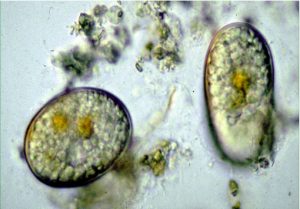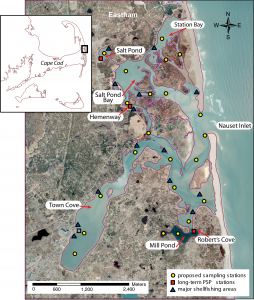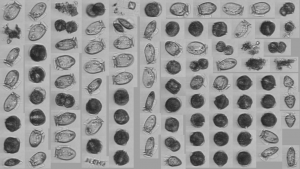Technology Enables Better HAB Monitoring and Mapping
Sept. 2018 -- Nauset Marsh in Eastham, Mass. on Cape Cod serves as a “natural laboratory” for researchers working to better understand harmful algal blooms (HABs) or red tide. HABs in Nauset are caused by the phytoplankton Alexandrium, which produces a toxin that causes Paralytic Shellfish Poisoning (PSP) in humans.
With funding from Woods Hole Sea Grant, WHOI biologist Mike Brosnahan field-tested a novel sampling system call the high throughput Imaging Flow Cytobot or IFCB-HT, an advance on the IFCB, which continuously records microscope images of phytoplankton and identifies them in real time, enabling scientists to detect the presence of harmful algal bloom species in the water.
“One of the things that has been really remarkable in studying Nauset is that blooms there develop very, very fast,” Brosnahan says. “By looking at the images from the IFCB-HT, we can see how the size of the cells changes throughout the day and actually estimate how fast the cells are growing.”
The high throughput system analyzes 2-1/2 liters of water in a day, 10 times as much water as the IFCB. This means the instrument records many more images of rare cell types, says Brosnahan. For example, he was able record short-lived life cycle stages of Alexandrium that happen quickly and are difficult to observe.
“There are these really dramatic shifts in the population at one stage of its life cycle,” explains Brosnahan. The transition point that interests Brosnahan occurs sometime after the Alexandrium cells travel from the seafloor to the water’s surface to photosynthesize, grow and divide.
“All these cells that are growing and dividing suddenly change into gametes – germ cells like sperm or eggs,” he says. “They’re formed very quickly, and an individual gamete may be in the water only for an hour or so before it finds another gamete and fuses to form another swimming stage called a planozygote.”
Because this stage is short lived, it is difficult to study. But the IFCB-HT allows scientists to look at lots more cells, providing a window into the mechanisms that govern HAB outbreaks and ultimately assist in their management.
The knowledge gained using the datasets collected at Nauset is helping scientists to better understand the much larger coastal blooms that occur in the Gulf of Maine and can affect shellfish throughout the Northeast.
“It’s much more challenging to study that bloom because it covers such a wide area. But by learning things about the behavior of the organism – how fast it grows, how it undergoes this life cycle process – the idea is that we’re going to be able to do a better job of forecasting and predicting the behavior of the coastal bloom as well,” Brosnahan says.

HABs in Nauset are caused by the phytoplankton Alexandrium, which produces a toxin that causes Paralytic Shellfish Poisoning (PSP) in humans.
In addition to applying their knowledge to the Gulf of Maine coastal blooms, the researchers are also testing their technology there. As part of his Woods Hole Sea Grant project, Brosnahan and his colleagues installed the IFCB-HT on a coastal research vessel during a small bloom in the Gulf of Maine to try to quickly develop a map of the distribution of cells in that large area.
“The system worked really well,” according to Brosnahan. “I stepped off the boat with a map of where the Alexandrium were. It was totally effective.”
This research led to support from the National Science Foundation and the National Institute of Environmental Health Sciences (NSF-NIEHS) Coastal Oceans and Human Health Program to continue studies in Nauset Marsh on the public health consequences of harmful algal blooms.
“Many small Woods Hole Sea Grant awards develop into major research programs with up to a ten-fold increase in dollars from other funding agencies,” says Woods Hole Sea Grant Director Matt Charette.
“I’m tremendously grateful for support from Sea Grant,” says Brosnahan. “This award from the Woods Hole program has allowed me to conduct several proof of concept studies with this new IFCB technology. Our results are directly informing several new projects that aim to better protect society from the dangers posed by HABs while also making these technologies more accessible to new users involved in natural resource management and industry.”
Education: Links to education activities and Resources related to HAB research
- Bad Algae! This lesson for grades 9-12 answers the question, “what are harmful algal blooms, and what can be done about them?”
https://oceanservice.noaa.gov/education/lessons/bad_algae.html - Toxic and Harmful Algal Blooms. These lessons for elementary through high school start with the basics of how algae fit in the food web and extend to the impacts of harmful algal blooms and what we can do about them.
https://archive.bigelow.org/edhab/ - In Full Bloom. This lesson is for grades 9-12 and is part of the BRIDGE data series. Compare concentrations of harmful algal blooms using NOAA’s Coastal Services Center Harmful Algal Bloom Forecasting (HABF) Project data.
http://www2.vims.edu/bridge/DATA.cfm?Bridge_Location=archive0402.html - McLane Research Labs. This website give you a general overview of the Imaging FlowCytobot (IFCB). If you scroll to the bottom you can see a live stream of images from an IFCB deployed in-situ at the Martha’s Vineyard Coastal Observatory as well as a HAB sensitive salt pond on Cape Cod.
http://www.whoi.edu/oceanus/viewArticle.do?id=46486


